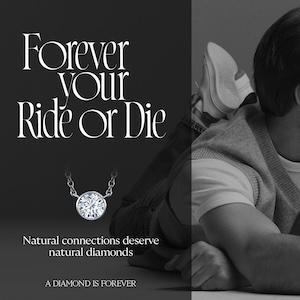
Despite significant “headwinds,” independent jewelers’ sales have mostly held up, even if they’ve dropped a bit from pandemic levels, agreed participants on the “360-Degree View of 2023” panel at the American Gem Society (AGS) Conclave in Louisville, Ky., that was moderated by this author.
Sherry Smith, director of business development for the Edge Retail Academy, said her stats showed that in the first quarter of 2023, both smaller and larger independent stores saw increased sales, while midsize retailers—defined as $3 million to $6 million—took a hit. Overall, independent jewelers’ sales fell 3%, she said, with the average order price down and unit sales flat.
“The good news is [during COVID] jewelers had a huge, huge increase, and we’re still holding on to that, within single digits,” she said. “And that’s something to celebrate.”
Erich Jacobs, president of the Jewelers Board of Trade, mostly concurred, but said his stats showed growing jitters from the vendor community.
“As long as folks maintain their inventory and innovation discipline, they’ll be okay,” Jacobs said. But he warned: “The ability to get capital is tightening. There’s a 30% increase in the number of small business lenders who said they are tightening their standards.”
Holly Wesche, owner of Wesche Jewelers of Melbourne, Fla., said, “I don’t know of any colleague of mine that doesn’t feel the headwinds.
“It was glory days in 2021 and 2022,” she said. “Now we have to go back to clienteling and really doing some of the hard work. Even some of my own sales team will admit it was so easy in 2021. You just sit back and take the money. People couldn’t travel, they couldn’t do other things. Now we have to really work at it.”
The challenge is to “not become complacent and fall into old ways,” Wesche added. “COVID forced us to get creative and to get out of the traditional box. I don’t want to lose that.
“It’s easy to worry that people don’t want to buy, that consumers are looking at their stock portfolios. Yes, those things are true, but we still have a great product, we have a great story, and there’s a lot of people who still have the ability to buy. It’s challenging, but there’s still lots of opportunity.”
Smith agreed that while the jewelry business has been traditionally slow to evolve, the pandemic woke a lot of people up. “Jewelers became stronger with their online presence and digital identity. They started being more strategic about measuring marketing initiatives, which ones are actually driving people in. Clienteling became huge. We always hear from retailers that they have no time to do it. But when times are good, they can’t afford not to do it. Because even when times are good, you are leaving potential sales out there and paying tons of money for customer acquisition.”
Wesche noted that her sales team does a significant amount of selling by text. “They customize videos, we put music to it. We’ll do it not only on social media but they’ll make a video just for a specific customer, and put music behind and send it. I’m kind of shocked by how much we sell by that vehicle.”
Wesche’s new mantra is “clienteling, clienteling, clienteling.”
She explained: “It’s reaching out to customers, creating reasons for them to buy, getting them excited about the new product. For us, that has been the key to keep pace.”
In-store events have also been very strong for sales lately, she said. “People aren’t thinking about gas prices and other things at a special event. If they are at a party and having a great time, the sales flow. We’re constantly trying to raise the bar with our events, thinking of ways to make them special and fun.”
She also recommended that retailers embrace digital tools like Podium, Apple Pay, and Venmo. “It has to be easy to send the video and then have customers pay,” she said. “They shouldn’t have to call you up with a credit card and then come in the store. We want a friction-free retail selling experience, and easy pay is one of those methods.”
As far as online, most luxury jewelry purchases are still done at brick-and-mortar stores, Smith said. Online luxury jewelry sales fell in 2022, she said, and currently comprise about 10% of the luxury jewelry market.
“With a luxury purchase, people want to touch it and want to try it on, and they want instant gratification. For even the best jewelers, online is only 4% of their business.”
Web searches for jewelry peaked in December, Jacobs said, but dropped this year for Valentine’s Day and Mother’s Day.
“There is a whole bunch of Shopify-level online stores for jewelry popping up,” he said. “A lot of that is the lower-end, but we know from other industries, when that has happened, the likelihood of fraud goes up very quickly. So you get to a certain point, fraud’s going to be a problem for those online stores, because they became a vehicle for that to happen.”
Sales of lab-grown diamonds jumped 63% in the first quarter, with a 107% increase in units sold and 23% drop in average retail sale, Smith said. Natural diamond sales rose 7% in the first quarter. Units sold were up 55%, but average retail sale dropped 33%.
Wesche said her store sells lab-grown, though it doesn’t advertise it. “We had a lot of discussions with our staff—conceptually, emotionally, how do we feel about this. You have to learn a lot and deal with the price always dropping. It’s been a definite journey.”
Most lab-grown customers tend to stay within their budgets, opting for the bigger stone for their buck, she said.
“A lot of consumers still don’t understand what lab-grown diamond is,” she added. “Some think it’s like a Louis Vuitton knockoff, not the real thing. And then on the other side of the coin, you have consumers who think it’s fantastic, they can get a 2 ct. diamond.”
She said her store has seen an increase in sales of lab-grown fashion jewelry. “At our store, lab-grown and natural peacefully coexist,” she said. “We have a lot of very wealthy self-purchasing female consumers. They come in, and they may buy lab stud earrings or tennis bracelet. So her ensemble is mixing both. She’s viewing it as a fashion piece. It’s coexisting in her collection in her mind.”
Smith agreed lab-grown is “not going to go away” and retail margins are still strong, with manufacturers bearing the brunt of the price recent decreases.
She said: “It’s not just Generation Z and millennials coming in for lab-grown. Baby boomers are purchasing lab-grown. They are coexisting, just like bridge jewelry is coexisting with fine jewelry.”
Jacobs said that JBT has seen a lot of collections situations where “somebody has taken a lot of lab-grown diamonds, they didn’t sell them, they want to give them back to the person who sold them, and the person isn’t taking them back. The vendor will say, ‘No, they have depreciated in value’ and not accept them back.”
Smith said that, while diamonds tend to get most of the attention, sales of colored stones and watches have also done well.
(Photo: Getty Images)
Follow JCK on Instagram: @jckmagazineFollow JCK on Twitter: @jckmagazine
Follow JCK on Facebook: @jckmagazine





